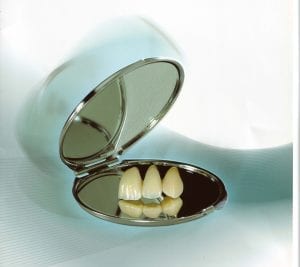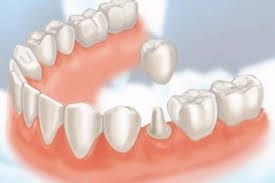Do you need to save your tooth, cover its decay or cracks, or keep it in one piece? For tooth that is on the verge of crumbling down, a tooth-shaped cap is usually placed over it, which is called a porcelain dental crown.
Porcelain crowns are effective means of improving your tooth’s appearance and are mainly used to cover teeth for the sake of restoring their strength, size, and shape. In many cases, they are more effective than dental filling when it comes to restoring teeth since they’re made of hard-wearing porcelain. They’re typically cemented into place in order to fully encase the visible portion of the tooth that’s above the gum line.
Why Is a Dental Crown Needed?
Porcelain crowns might be called for when dealing with the following circumstances.
- For children, a crown can be used with milk or baby teeth for:
- Decreasing the frequency of use of general anesthesia for kids unable to cope with the medication thanks to their youngness, medical history, or behavior that keeps them from cooperating with the requirements of correct dental care.
- Protection of children with a high risk of tooth decay, particularly those with difficulty keeping up with daily recommended habits of oral hygiene (brushing three times a day after every meal, flossing, and gargling with mouthwash).
- Saving any teeth that’s been so damaged by decay and caries that a filling isn’t enough to support them. A pediatric dentist will typically recommend you get a stainless steel crown rather than a porcelain one.
- For adults, a crown can be used with permanent teeth for:
- Protecting a weak tooth that’s broken or decayed from deteriorating any further. It can even hold down parts of a tooth that’s cracked as well.
- Providing cosmetic modification.
- Restoring a cracked or broken tooth as well as any teeth that have been severely worn down after years of hard biting and usage.
- Covering a dental implant or serving as replacement teeth with the implant serving as the replacement tooth root.
- Supporting and protecting a tooth with a large filling when there’s not much tooth left, but the tooth root is still intact.
- Covering or hiding a misshapen or severely discolored tooth.
- Holding a dental bridge into place as support.
How Much Does a Porcelain Crown Cost?
The prices of porcelain crowns vary depending on various factors. On average, you should expect to pay from a low $600 and up to $2,500 for a crown. This is a wide range, but there are certain factors that could ultimately affect the cost of the crown you’re availing of (naturally, if you use material other than porcelain, you can go below or above the $600-$2,500 range altogether).

You can affect the cost of the crown depending on the dentist’s experience, the dental lab being used to create the crown, the material being used, and the location of the operation. You can avail of discounts if you pay out of pocket. Otherwise, if you have a dental plan available, that can be considered a discount for your porcelain crowns in and of themselves. Discounts can also be achieved if the clinic takes out a lot of insurances.
Materials of the Crown
To wit, here’s a breakdown of the different materials you can avail of when it comes to dental crowns:
- Porcelain Fused to Metal Crown: This type of porcelain crowns is made of metal and coated with porcelain, so you have a metal interior and a porcelain shell for teeth rather than an outright metallic crown. They’re strong and also cheap to make. However, there’s a downside in terms of aesthetics. If you look closely, the metal base can appear above the gum line.
- All-Porcelain Crowns: This type of porcelain crown has a better appearance and most patients are willing to pay for them for their cosmetic and aesthetic superiority to the porcelain-coated metal crown. These crowns are known to be great and nicer for the sake of cosmetic treatment. However, because they’re metal-free, they’re weaker than their cheaper counterpart. They’re best suited for front teeth replacement.
- Zirconium Crowns: Zirconium crowns are about as strong as metal, but as aesthetically pleasing as all-porcelain crowns. This is because dental crowns of this type are tooth-colored. Zirconium can be synthesized to look like teeth from the get go without porcelain coatings and whatnot, while still retaining the toughness you’d expect from metal crowns.
- Gold Crowns: If you wish to have the classic pirate or an old west cowboy look, you can opt for gold teeth. Just remember they’re best used in molars and rarely utilized for front teeth (incisor and canine) usage. Gold can also be utilized as the base of the crown while utilizing a porcelain covering or shell on top of it. Naturally, this is the most expensive option of all the materials.
Skills of the Dentist

In regards to the skills of the dentist, your options can be limited or expanded by what your dentist can do or not do. His arsenal and options will dictate which dental crown choices are available to you when it comes to porcelain crowns (or other crown types). The lab that they get their crowns from can also dictate which of the different kinds of crown are available to you for your crown operation.
There are dentists who can only do one type of crown and won’t give you any other options because of the lab they depend on porcelain crowns synthesis. When all is said and done, when it comes to crowns, you get what you pay for. You can have a crown made of diamonds, but if the dentist is inexperienced in placing it within your mouth, it will still require replacing or result in oral damage or infections.
The dentist’s technical skill and the competence of the laboratory making your crowns is the key to how appropriate the pricing of the procedure is. Dentists who are veterans in the crown insertion industry know the crown’s value they’re offering to you, the patient, and will accordingly charge the right price for it. Quality is of the utmost importance. You’re paying more for dentists stateside because they guarantee western dental standards and superior international-grade expertise.
Location and Dental Tourism
The cost porcelain crowns can vary from state to state, city to city, and country to country. A more affluent area will naturally have more expensive rates for porcelain crown procedures compared to less cosmopolitan places. However, sometimes you can “cheat” the system by taking your porcelain crown business elsewhere cheaper without sacrificing much in terms of overall quality, which is the case with dental tourism in Thailand.
Dental tourism is the act of mixing business and pleasure when traveling. If you’re due for a vacation, why not pool your money and save up for a dental tourism country like Thailand so that you can get your crowns done at the Thantakit International Dental Clinic then afterwards enjoy what the Kingdom of Thailand has to offer in terms of tours and attractions? It’s a sweet deal that allows you to kill two birds with one stone while saving a ton of money at the same time.
Guarantees and Do-Overs

If your porcelain crown costs over $1,200 as the out of pocket price, make sure you have a guarantee for it in writing so that you can get the crown replaced for free in case it breaks down within the first year or two of having it. If you’re paying that much, you should at least have an assurance that it can last at least within two years.
From there, if there’s something wrong with your porcelain (or otherwise) crown after two years, it’s reasonable for you to cover the lab cost (at the very least) in order to have it replaced (if you have a special deal with the dentist to have the operation done by him for free). Many insurance plans will provide coverage for a crown replacement for 5 years or so.
Otherwise, you might need to negotiate with your dentist in regards to replacing your crown. Clear communication with your designated dentist is essential. There are a number of dentists who are willing to replace or redo faulty work. The things that could go wrong with your dental crown is numerous, such as:
- The porcelain chipping or breaking.
- The cement sticking the crown to your tooth going loose.
- The crown getting dislodged or even swallowed.
- The crown ending up lost.
- The crown breaking or becoming deformed.
- The tooth root and the crown going loose together (might require a dental bridge or a separate dental implant operation to fix).
A Breakdown of Possible Costs for Crowns in Europe
Here’s a breakdown of the possible prices you can get for porcelain crowns within Europe at the time of this writing.
- It costs €290 or $313 to get a porcelain crown fused to metal complete with a 5-year guarantee.
- It costs €290 or $313 to get a porcelain bridge unit fused to metal complete with a 5-year guarantee.
- It costs €460 or $496 to get a zirconium full porcelain crown complete with a 5-year guarantee.
- It costs €490 or $529 to get a zirconium full porcelain crown on implant complete with a 5-year guarantee.
- It costs €460 or $496 to get a zirconium full porcelain bridge unit complete with 5-year guarantee.
- It costs €500 or $539 to get a full porcelain crown complete with a 5-year guarantee.
- It costs €230 or $248 to get a zirconium implant abutment.
- It costs €550 or $593 to get a porcelain veneer complete with a 3-year guarantee.
- It’s free to get a temporary crown or bridge unit for your dental operation.
- It costs €80 or $86 to get a laboratory-made plastic/acrylic crown or bridge unit for long-term usage.
- It costs €50 or $54 to get aesthetic shoulder porcelain, complete with a 3-year guarantee.
- It costs €75 or $81 to get a post/core.
- A fiberglass post/core is free.
- A crown/bridge removal procedure is free.
A Breakdown of Possible Costs for Crowns in Thailand
Here’s a breakdown of the possible prices you can get for porcelain crowns within Thailand at the time of this writing.
- It costs ฿10,000 or $289 to get a porcelain crown or bridge fused to metal using standard alloy and no warranty.
- It costs ฿13,000 or $376 to get a porcelain crown or bridge fused with metal using palladium alloy and a 2-year warranty.
- It costs ฿18,000 or $520 to get a porcelain crown or bridged fused with metal using gold alloy and a 2-year warranty.
- It costs ฿20,000-฿25,000 or $578-$722 to get a porcelain crown or bridged fused with metal using high-grade gold alloy and a 2-year warranty. The price depends on the size of the crown.
- It costs ฿25,000-฿35,000 or $722-$1,012 to get a porcelain crown fused with metal on a dental implant and a 2-year warranty.
- It costs ฿18,000 or $520 to get a full ceramic CAD/CAM crown or bridge complete with a 2-year warranty.
- It costs ฿20,000 or $578 to get a full ceramic CAD/CAM crown or bridge using an intra-oral digital scanner complete with a 2-year warranty.
Insurance Details

Lesser insurance plans with no dental might not have coverage for dental crown replacement, especially those used strictly for cosmetic dentistry purposes. A more comprehensive plan with higher premiums should give you dental crown benefits, but they might have a cap on which porcelain crowns type they cover or how expensive they’re supposed to be.
Check your insurance details, particularly the section or classification dealing with “major” dental services. It’s possible that your existing dental insurance plan might provide coverage for up to 50 percent of the crown’s fee. However, there are certain exceptions to this porcelain crown insurance before you can receive full benefits. Possible policy restrictions might include the types of crowns allowed, justification for placement, wait periods, age restrictions, replacement intervals, and lost dental crowns.
Thantakit International Dental Center is Thailand’s longest established dental center. Situated in Bangkok, our clinic is renowned across the world as a destination for world-class dentistry, with most of our patients flying to us from Australia.
Please contact us today and get a FREE dental consultation.












